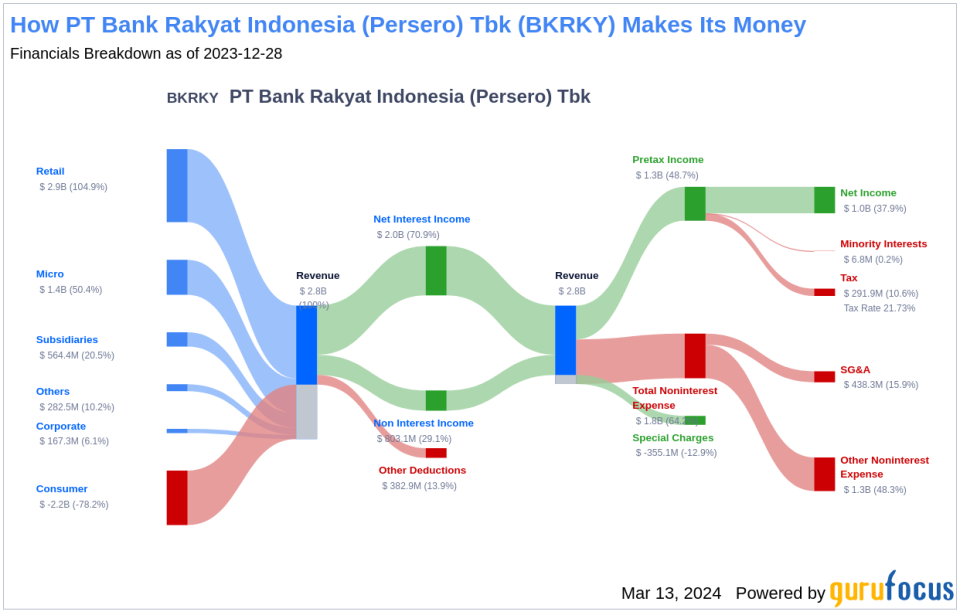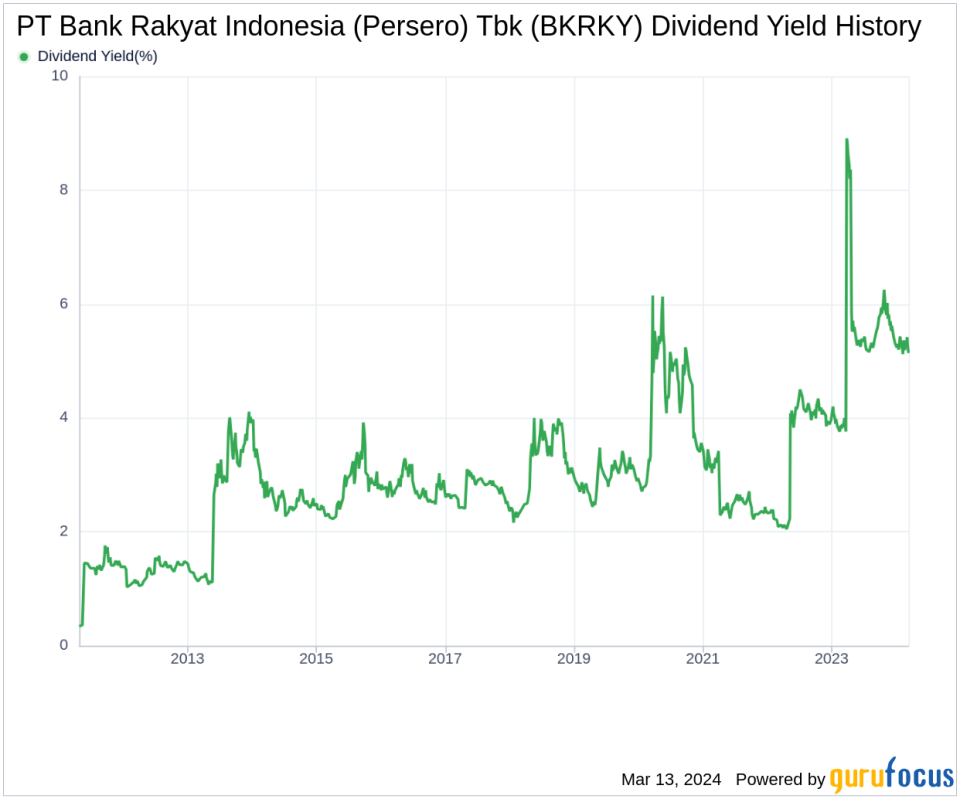PT Bank Rakyat Indonesia (Persero) Tbk's Dividend Analysis
Assessing the Dividend Profile of Indonesia's Premier Banking Institution
PT Bank Rakyat Indonesia (Persero) Tbk (BKRKY) recently announced a dividend of $0.75 per share, payable on 2024-04-12, with the ex-dividend date set for 2024-03-14. As investors look forward to this upcoming payment, the spotlight also shines on the company's dividend history, yield, and growth rates. Using the data from GuruFocus, let's look into PT Bank Rakyat Indonesia (Persero) Tbk's dividend performance and assess its sustainability.
What Does PT Bank Rakyat Indonesia (Persero) Tbk Do?
This Powerful Chart Made Peter Lynch 29% A Year For 13 Years
How to calculate the intrinsic value of a stock?
PT Bank Rakyat Indonesia (Persero) Tbk is Indonesia's oldest commercial bank, and operates primarily within the country's borders, with some exposure to North Asia. BRI focuses on providing and tailoring banking services to micro, small, and medium enterprises. Its segments are micro, retail, corporate, and others. The company emphasizes integrating financial technology into its various platforms to create ease of access for its customer base. Its core business services include collecting customer deposits, loan disbursement, issuing promissory notes and loan agreements, and collateralization of assets. Its loan products include working capital loans for corporate and commercial customers, and mortgages for consumer customers.
A Glimpse at PT Bank Rakyat Indonesia (Persero) Tbk's Dividend History
PT Bank Rakyat Indonesia (Persero) Tbk has maintained a consistent dividend payment record since 2009. Dividends are currently distributed on a quarterly basis. Below is a chart showing annual Dividends Per Share for tracking historical trends.
Breaking Down PT Bank Rakyat Indonesia (Persero) Tbk's Dividend Yield and Growth
As of today, PT Bank Rakyat Indonesia (Persero) Tbk currently has a 12-month trailing dividend yield of 5.16% and a 12-month forward dividend yield of 8.81%. This suggests an expectation of increased dividend payments over the next 12 months. Over the past three years, PT Bank Rakyat Indonesia (Persero) Tbk's annual dividend growth rate was 34.50%. Extended to a five-year horizon, this rate decreased to 23.20% per year. And over the past decade, PT Bank Rakyat Indonesia (Persero) Tbk's annual dividends per share growth rate stands at an impressive 20.20%.
Based on PT Bank Rakyat Indonesia (Persero) Tbk's dividend yield and five-year growth rate, the 5-year yield on cost of PT Bank Rakyat Indonesia (Persero) Tbk stock as of today is approximately 14.65%.
The Sustainability Question: Payout Ratio and Profitability
To assess the sustainability of the dividend, one needs to evaluate the company's payout ratio. The dividend payout ratio provides insights into the portion of earnings the company distributes as dividends. A lower ratio suggests that the company retains a significant part of its earnings, thereby ensuring the availability of funds for future growth and unexpected downturns. As of 2023-12-31, PT Bank Rakyat Indonesia (Persero) Tbk's dividend payout ratio is 1.22, which may suggest that the company's dividend may not be sustainable.
PT Bank Rakyat Indonesia (Persero) Tbk's profitability rank, offers an understanding of the company's earnings prowess relative to its peers. GuruFocus ranks PT Bank Rakyat Indonesia (Persero) Tbk's profitability 6 out of 10 as of 2023-12-31, suggesting fair profitability. The company has reported positive net income for each of year over the past decade, further solidifying its high profitability.
Growth Metrics: The Future Outlook
To ensure the sustainability of dividends, a company must have robust growth metrics. PT Bank Rakyat Indonesia (Persero) Tbk's growth rank of 6 out of 10 suggests that the company has a fair growth outlook. Revenue is the lifeblood of any company, and PT Bank Rakyat Indonesia (Persero) Tbk's revenue per share, combined with the 3-year revenue growth rate, indicates a strong revenue model. PT Bank Rakyat Indonesia (Persero) Tbk's revenue has increased by approximately 3.10% per year on average, a rate that underperforms approximately 70.21% of global competitors.
The company's 3-year EPS growth rate showcases its capability to grow its earnings, a critical component for sustaining dividends in the long run. During the past three years, PT Bank Rakyat Indonesia (Persero) Tbk's earnings increased by approximately 41.50% per year on average, a rate that underperforms approximately 11.87% of global competitors. Lastly, the company's 5-year EBITDA growth rate of 7.30%, which underperforms approximately 52.02% of global competitors.
Next Steps
Considering PT Bank Rakyat Indonesia (Persero) Tbk's dividend payments, dividend growth rate, payout ratio, profitability, and growth metrics, investors have much to ponder. While the bank's dividend history and yield on cost are attractive, the sustainability of its dividend in light of the payout ratio and growth metrics warrants careful consideration. Investors should weigh the strong dividend growth against the company's average growth outlook and the potential implications of its payout ratio. With PT Bank Rakyat Indonesia (Persero) Tbk's commitment to financial technology and its presence in the Southeast Asian market, it remains a potentially compelling choice for dividend-seeking investors who are comfortable with emerging market risks.
GuruFocus Premium users can screen for high-dividend yield stocks using the High Dividend Yield Screener.
This article, generated by GuruFocus, is designed to provide general insights and is not tailored financial advice. Our commentary is rooted in historical data and analyst projections, utilizing an impartial methodology, and is not intended to serve as specific investment guidance. It does not formulate a recommendation to purchase or divest any stock and does not consider individual investment objectives or financial circumstances. Our objective is to deliver long-term, fundamental data-driven analysis. Be aware that our analysis might not incorporate the most recent, price-sensitive company announcements or qualitative information. GuruFocus holds no position in the stocks mentioned herein.
This article first appeared on GuruFocus.


